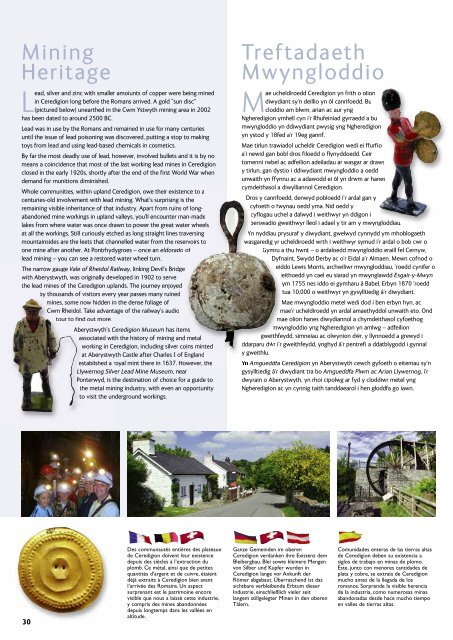Ceredigion Coast Path - Brochures - Visit Wales
Ceredigion Coast Path - Brochures - Visit Wales
Ceredigion Coast Path - Brochures - Visit Wales
You also want an ePaper? Increase the reach of your titles
YUMPU automatically turns print PDFs into web optimized ePapers that Google loves.
Mining<br />
Heritage<br />
Lead, silver and zinc with smaller amoiunts of copper were being mined<br />
in <strong>Ceredigion</strong> long before the Romans arrived. A gold “sun disc”<br />
(pictured below) unearthed in the Cwm Ystwyth mining area in 2002<br />
has been dated to around 2500 BC.<br />
Lead was in use by the Romans and remained in use for many centuries<br />
until the issue of lead poisoning was discovered, putting a stop to making<br />
toys from lead and using lead-based chemicals in cosmetics.<br />
By far the most deadly use of lead, however, involved bullets and it is by no<br />
means a coincidence that most of the last working lead mines in <strong>Ceredigion</strong><br />
closed in the early 1920s, shortly after the end of the first World War when<br />
demand for munitions diminished.<br />
Whole communities, within upland <strong>Ceredigion</strong>, owe their existence to a<br />
centuries-old involvement with lead mining. What’s surprising is the<br />
remaining visible inheritance of that industry. Apart from ruins of longabandoned<br />
mine workings in upland valleys, you’ll encounter man-made<br />
lakes from where water was once drawn to power the great water wheels<br />
at all the workings. Still curiously etched as long straight lines traversing<br />
mountainsides are the leets that channelled water from the reservoirs to<br />
one mine after another. At Pontrhydygroes – once an eldorado of<br />
lead mining – you can see a restored water wheel turn.<br />
The narrow gauge Vale of Rheidol Railway, linking Devil’s Bridge<br />
with Aberystwyth, was originally developed in 1902 to serve<br />
the lead mines of the <strong>Ceredigion</strong> uplands. The journey enjoyed<br />
by thousands of visitors every year passes many ruined<br />
mines, some now hidden in the dense foliage of<br />
Cwm Rheidol. Take advantage of the railway’s audio<br />
tour to find out more.<br />
Aberystwyth’s <strong>Ceredigion</strong> Museum has items<br />
associated with the history of mining and metal<br />
working in <strong>Ceredigion</strong>, including silver coins minted<br />
at Aberystwyth Castle after Charles I of England<br />
established a royal mint there in 1637. However, the<br />
Llywernog Silver Lead Mine Museum, near<br />
Ponterwyd, is the destination of choice for a guide to<br />
the metal mining industry, with even an opportunity<br />
to visit the underground workings.<br />
30<br />
Des communautés entières des plateaux<br />
de <strong>Ceredigion</strong> doivent leur existence<br />
depuis des siècles à l’extraction du<br />
plomb. Ce métal, ainsi que de petites<br />
quantités d’argent et de cuivre, étaient<br />
déjà extraits à <strong>Ceredigion</strong> bien avant<br />
l’arrivée des Romains. Un aspect<br />
surprenant est le patrimoine encore<br />
visible que nous a laissé cette industrie,<br />
y compris des mines abandonnées<br />
depuis longtemps dans les vallées en<br />
altitude.<br />
Treftadaeth<br />
Mwyngloddio<br />
Mae ucheldiroedd <strong>Ceredigion</strong> yn frith o olion<br />
diwydiant sy’n deillio yn ôl canrifoedd. Bu<br />
cloddio am blwm, arian ac aur yng<br />
Ngheredigion ymhell cyn i’r Rhufeiniad gyrraedd a bu<br />
mwyngloddio yn ddiwydiant pwysig yng Ngheredigion<br />
yn ystod y 18fed a'r 19eg ganrif.<br />
Mae tirlun trawiadol ucheldir <strong>Ceredigion</strong> wedi ei ffurfio<br />
a’i newid gan bobl dros filoedd o flynyddoedd. Ceir<br />
tomenni rwbel ac adfeilion adeiladau ar wasgar ar draws<br />
y tirlun, gan dystio i ddiwydiant mwyngloddio a oedd<br />
unwaith yn ffynnu ac a adawodd ei ôl yn drwm ar hanes<br />
cymdeithasol a diwylliannol <strong>Ceredigion</strong>.<br />
Dros y canrifoedd, denwyd pobloedd i’r ardal gan y<br />
cyfoeth o fwynau oedd yma. Nid oedd y<br />
cyflogau uchel a dalwyd i weithwyr yn ddigon i<br />
berswadio gweithwyr lleol i adael y tir am y mwyngloddiau.<br />
Yn nyddiau prysuraf y diwydiant, gwelwyd cynnydd ym mhoblogaeth<br />
wasgaredig yr ucheldiroedd wrth i weithwyr symud i’r ardal o bob cwr o<br />
Gymru a thu hwnt – o ardaloedd mwyngloddio eraill fel Cernyw,<br />
Dyfnaint, Swydd Derby ac o’r Eidal a’r Almaen. Mewn cofnod o<br />
eiddo Lewis Morris, archwiliwr mwyngloddiau, ’roedd cynifer o<br />
ieithoedd yn cael eu siarad yn mwynglawdd Esgair-y-Mwyn<br />
ym 1755 nes iddo ei gymharu â Babel. Erbyn 1870 ’roedd<br />
tua 10,000 o weithwyr yn gysylltiedig â’r diwydiant.<br />
Mae mwyngloddio metel wedi dod i ben erbyn hyn, ac<br />
mae’r ucheldiroedd yn ardal amaethyddol unwaith eto. Ond<br />
mae olion hanes diwydiannol a chymdeithasol cyfoethog<br />
mwyngloddio yng Ngheredigion yn amlwg – adfeilion<br />
gweithfeydd, simneiau ac olwynion dwˆr, y llynnoedd a grewyd i<br />
ddarparu dwˆr i’r gweithfeydd, ynghyd â’r pentrefi a ddatblygodd i gynnal<br />
y gweithlu.<br />
Yn Amgueddfa <strong>Ceredigion</strong> yn Aberystwyth cewch gyfoeth o eitemau sy’n<br />
gysylltiedig â’r diwydiant tra bo Amgueddfa Plwm ac Arian Llywernog, i’r<br />
dwyrain o Aberystwyth, yn rhoi cipolwg ar fyd y cloddiwr metel yng<br />
Ngheredigion ac yn cynnig taith tanddaearol i hen gloddfa go iawn.<br />
Ganze Gemeinden im oberen<br />
<strong>Ceredigion</strong> verdanken ihre Existenz dem<br />
Bleibergbau. Blei sowie kleinere Mengen<br />
von Silber und Kupfer wurden in<br />
<strong>Ceredigion</strong> lange vor Ankunft der<br />
Römer abgebaut. Überraschend ist das<br />
sichtbare verbleibende Erbtum dieser<br />
Industrie, einschließlich vieler seit<br />
langem stillgelegter Minen in den oberen<br />
Tälern.<br />
Comunidades enteras de las tierras altas<br />
de <strong>Ceredigion</strong> deben su existencia a<br />
siglos de trabajo en minas de plomo.<br />
Éste, junto con menores cantidades de<br />
plata y cobre, se extraía de <strong>Ceredigion</strong><br />
mucho antes de la llegada de los<br />
romanos. Sorprende la visible herencia<br />
de la industria, como numerosas minas<br />
abandonadas desde hace mucho tiempo<br />
en valles de tierras altas.


